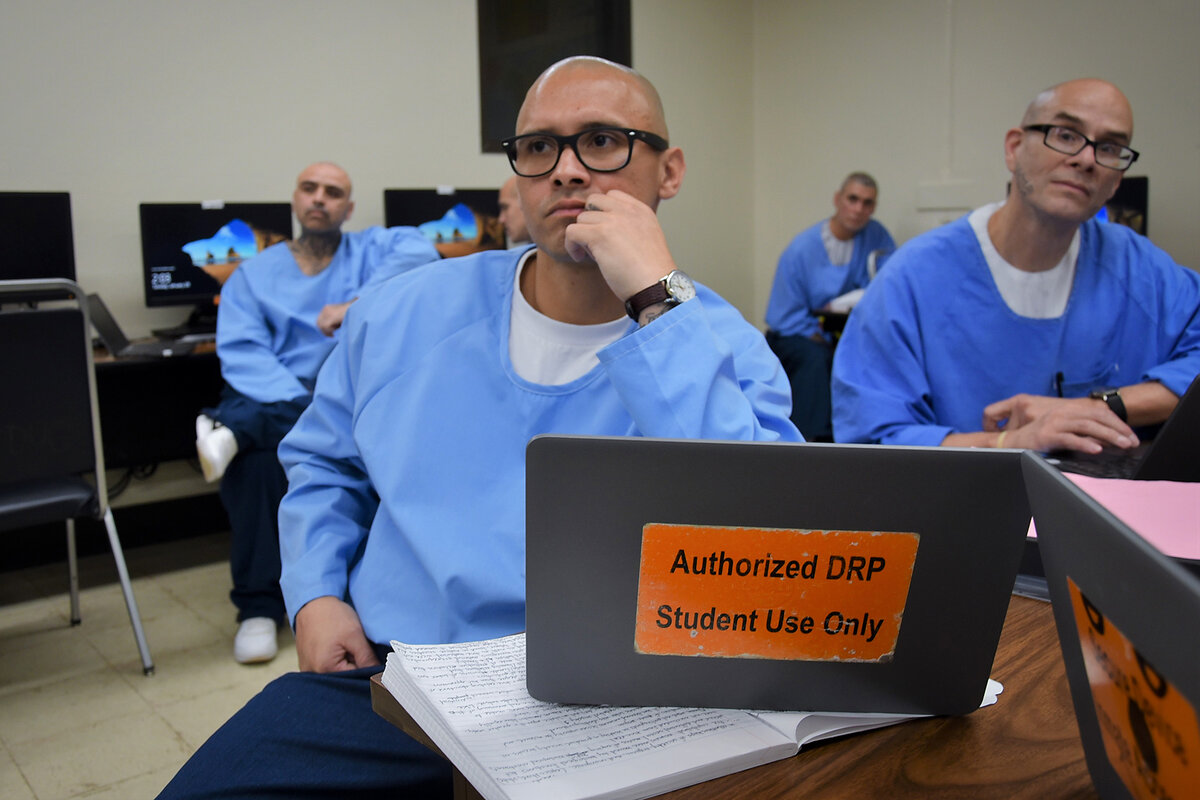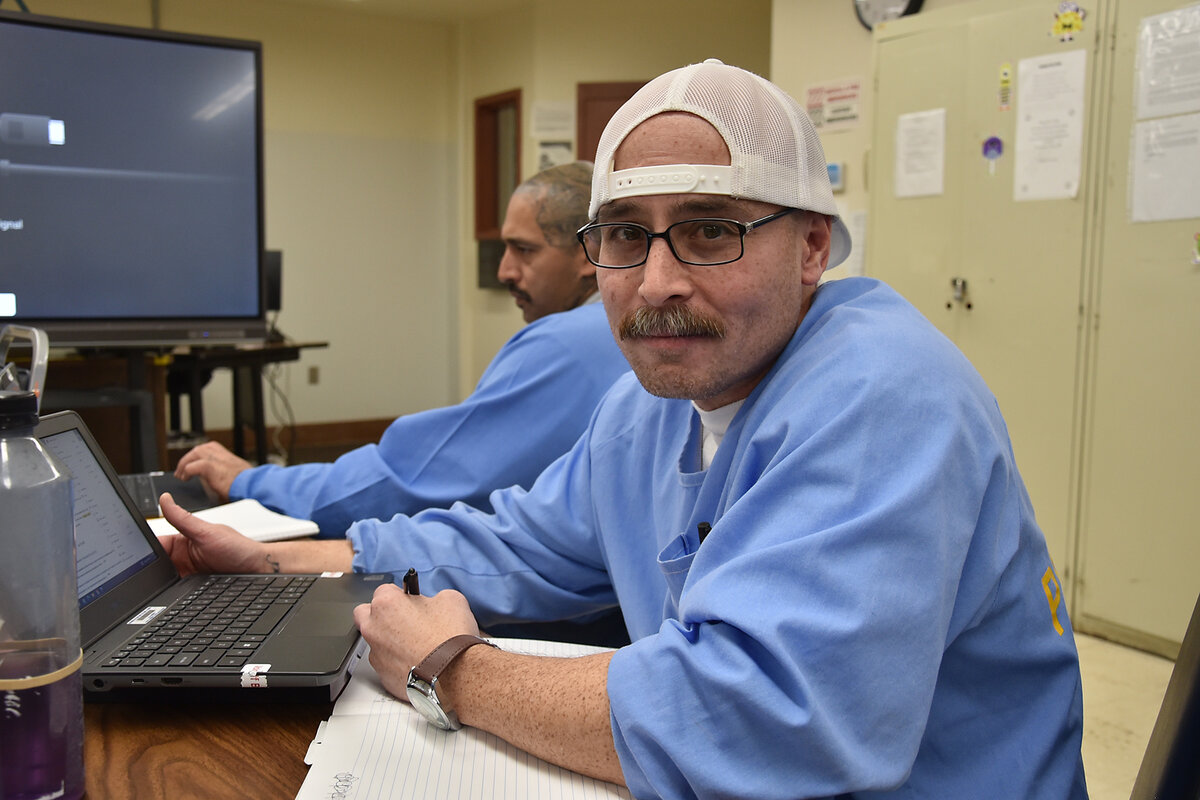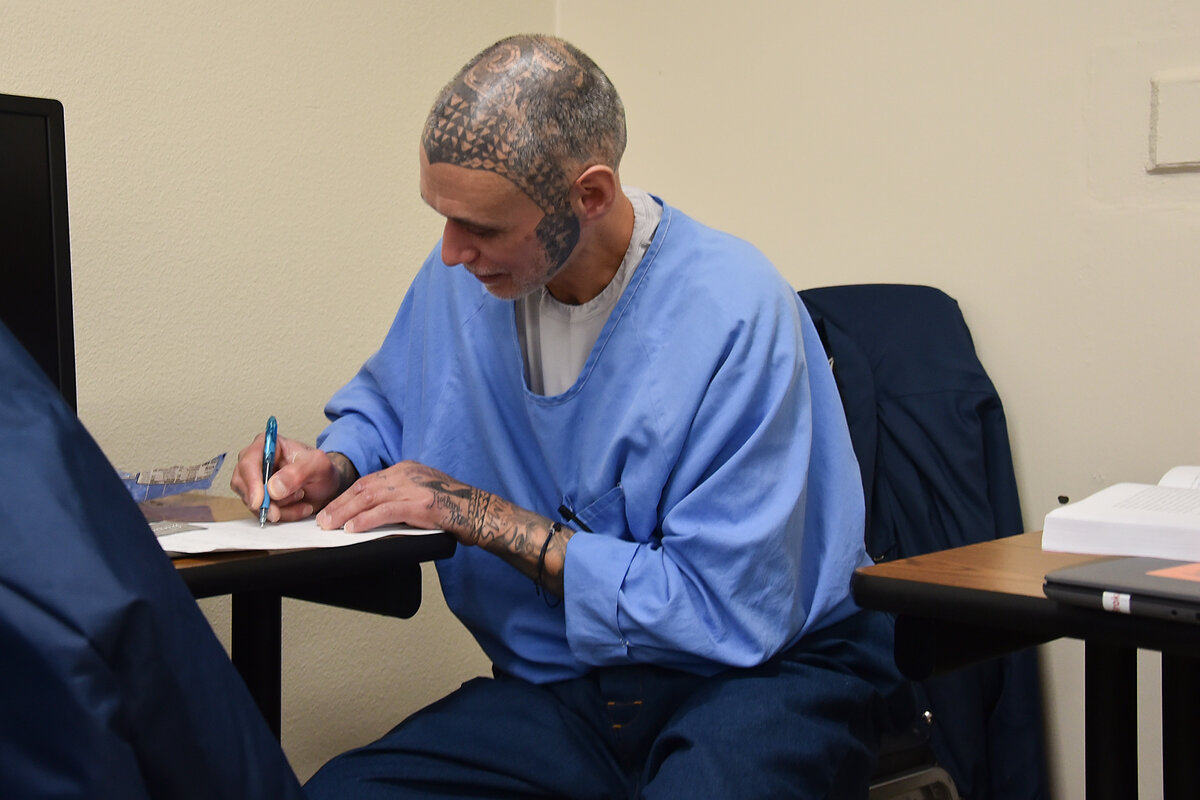Pelican Bay offers a model for prison education. Its future is in doubt.
Loading...
| Crescent City, Calif.
Behind razor wire and guard towers, an experiment in higher education is unfolding.
California’s first supermax facility spawned dozens of imitators during the 1990s. In its Security Housing Unit, prisoners were allowed just 90 minutes of sunlight a day. Long stretches of solitary confinement were the norm.
Today, Pelican Bay State Prison wants to be a model again. One 900-square-foot classroom, lined with computers, is now an accredited part of California State Polytechnic University, Humboldt. On a recent Tuesday, 27 men were inside working toward their college degrees. They are the first incarcerated college students to receive federal aid in more than 30 years. It’s also the state’s first in-person bachelor’s initiative inside a maximum security yard.
Why We Wrote This
A story focused onAmong the second chances offered in U.S. prisons is the first in-person bachelor’s degree program inside a maximum security yard. Early in the spring semester, its future is suddenly in doubt.
And just two weeks into the spring semester, its future is suddenly in doubt.
The bachelor’s program is a groundbreaking partnership between California’s most rural prison and its most rural state university. Over three years, officials from Cal Poly Humboldt and the California Department of Corrections and Rehabilitation designed the first prison education program taught face-to-face in a Level 4 security yard. All individuals in the Level 4 yard are here for violent or gang-related offenses.
There’s no wrong reason to support prison programs, says Ruth Delaney, director of the Unlocking Potential initiative at the Vera Institute of Justice. “Access to postsecondary education in prison makes corrections facilities safer for the people who live and work in prisons. It improves students’ sense of self-worth, communication skills, and reduces the odds of recidivism,” says Ms. Delaney.
“The more opportunities we have for people to get into these programs, the more success and positive outcomes that we’re going to see,” she adds.
What incarcerated people gain
Education gives people the tools to reflect on their past and understand how they got here, says program coordinator Mark Taylor of Project Rebound Humboldt, sitting in an office at Pelican Bay.
“When you can understand the scope of the harm you’ve caused, that’s one thing that will stop you from harming again. That certainly helped me,” says Mr. Taylor, who earned six associate degrees with a 4.0 GPA while incarcerated in Ironwood State Prison. He was paroled after serving two decades and went on to earn his bachelor’s and master’s degrees from Cal Poly Humboldt. Education transformed him, he says, and he helped set up the program so it could transform others.
Research shows that the higher the level of education someone achieves while in prison, the less likely they are to be arrested again once released and the more likely they are to find a job. Advocates for prison programs argue, too, that investing in education is more cost-effective than investing in more prisons.
In California, the rate of individuals who are reconvicted within three years of release has remained around 49%, according to the most recent data from the Department of Corrections. However, for those who get support from Project Rebound, an on-campus group for formerly incarcerated individuals, that figure drops to less than 1%.
Education is a fundamental investment for incarcerated people, says Jenn Capps, provost and vice president for academic affairs at Cal Poly Humboldt. “When education is offered, and students have access to factual information, they’re often taught to think critically, communicate, and work through thoughts and feelings.”
“A deep drive for their own education”
Every week, faculty members from the main campus of Cal Poly Humboldt in Arcata travel 80 miles to the prison in Crescent City to teach.
“It’s one of the most engaged intellectual spaces I’ve taught, and they can tell when you’re phoning it in,” says Maxwell Schnurer, chair of the communication department who teaches at the prison once a week. “They’re still college juniors who make spelling errors and have lots to learn. But they come to the table with a deep drive for their own education.”
Antonio Barajas wants to graduate with his bachelor’s before his parole board hearing at the end of 2026. He hopes to pursue a master’s in psychology with Project Rebound Humboldt.
For Mr. Barajas, education isn’t just about a degree – it’s about gaining the tools to better understand himself and others. “When you grow up in a certain environment, bad behavior gets reinforced,” he says in an interview at the prison. “Education gives you the tools to start asking questions.”
“My life is going to be dedicated to making amends for a lot of the harm I’ve done,” says Mr. Barajas, referring to a fatal shooting that left one person dead.
California has led the way in prison education, since a 2014 ruling required community colleges to set up programs for incarcerated students. Today, more than two dozen community colleges and eight state universities offer degree-granting programs that now cover every facility in the state.
About 14,000 incarcerated individuals in the state are taking classes toward a college degree, or about 15% of the prison population. Most are pursuing an associate degree. Around 350 individuals are working toward their bachelor’s degrees.
Following a series of hunger strikes within the prison for more educational opportunities and better conditions, college education began at Pelican Bay in 2015 with an associate degree program with another college.
All the men in the classroom earned GED certificates or high school diplomas while they were incarcerated. To be eligible for the bachelor’s degree program, they must already have an associate degree, be in good academic standing, and exhibit good behavior.
For student Davion Holman, education gives him the chance to rewrite the story he once believed about himself. “I always knew I was smart,” he says. “I just didn’t have the tools.”
“Now I see I was a product of my environment. I chose that because that’s all I knew,” says Mr. Holman, who is serving 31 years for second-degree robbery. “The way to change people’s perceptions of who we are is to show them what we can become.”
Fellow student Steve Corotan says there’s a brotherhood in the classroom. He spent 17 years in solitary confinement, and “remembers a time when Black and Brown couldn’t be on the same basketball court. Now we’re in the classroom together, doing projects and studying together.”
While the program represents a second chance at education, Mr. Taylor says, “Some never even had a first. This is their first chance to be able to succeed.”
An executive order, an uncertain future
Two weeks into the spring semester, the White House announced that all federal loans and grants would be paused, sending the bachelor’s program into a tailspin.
The executive order penned by President Donald Trump Jan. 28 halts funding for all “diversity, equity, inclusion, and accessibility” policies and programs, “under whatever name they appear.”
“I’m very worried,” says Steve Ladwig, director of the bachelor’s program and Project Rebound Humboldt. “Everything we do is successful because of our commitment to diversity, equity, and inclusion. The university prides itself on who we include, not who we exclude,” he says.
The Pelican Bay program was the inaugural recipient of the Second Chance Pell Grant, which provides federal support in the form of tuition for incarcerated students. That funding is also in jeopardy, as is the Education Department itself.
It’s nearly impossible to pay for the project without those federal funds, says Mr. Taylor. “The bachelor’s program was structured entirely around those grants,” he says. The majority of students are Pell Grant recipients and Black, Latino, or Native American. Two-thirds have maintained a GPA of 3.0 or higher.
The bachelor’s program has a three-year contract with the Department of Justice until summer 2026. If the grants are unable to be renewed, Mr. Ladwig says the program will pursue other funding, including philanthropic sources.
Mr. Ladwig sees a logic that could be easily explained to anyone interested in return on investment.
“You could invest $8,000 in tuition or invest $132,000 to keep someone incarcerated for 30 years. I’m going to go with $8,000 for four years ... and they’ll never come back to prison,” says Mr. Ladwig.
For student William Kaleipuaokam Hopeau, education started with a promise. In 2004, his teenage daughter – struggling in school and tempted by the same path that led him to prison – came back into his life.
To prevent her from following his footsteps, he made a pact: “If I graduate, then you graduate.” She finished first, but in 2008, Mr. Hopeau earned his associate degree from Coastline College.
“I’d already missed so much of her life,” he says. “I didn’t want to let her down.”
Mr. Hopeau’s education became more than self-improvement – it was proof that change was possible, for both of them. “Now I can show my grandkids that education does pay off,” he says.









